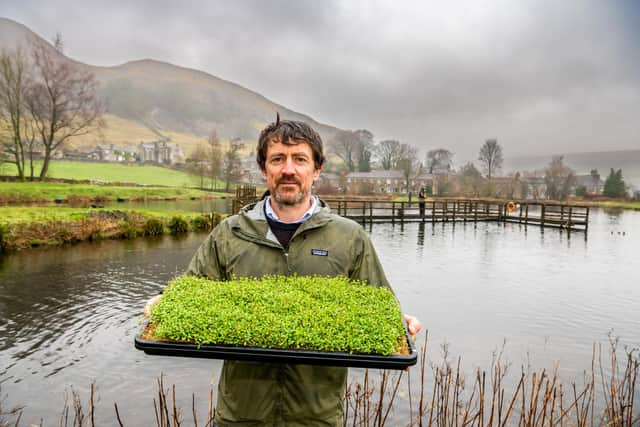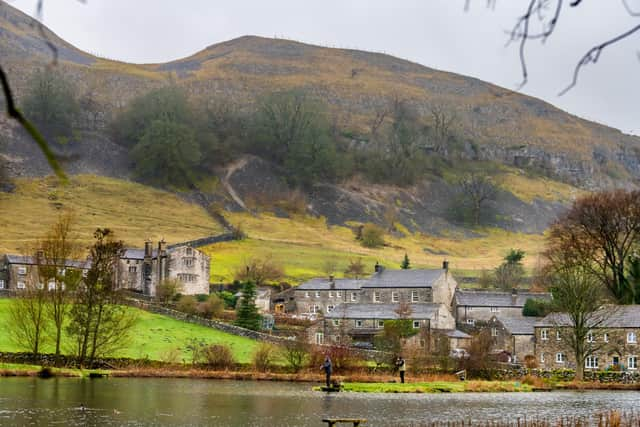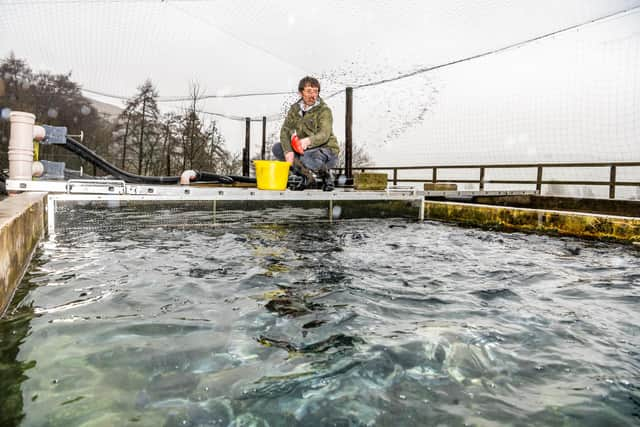How Kilnsey Estate in the Yorkshire Dales keeps evolving after four generations in the same family
Jamie Roberts is the fourth generation to farm here alongside his parents Anthony and Vanessa. He’s the man now responsible on a day-to-day basis for the family’s Kilnsey Estate, which runs to 2000 acres, has tenant farmers and is home to Kilnsey Show, and that it all carries on in the family name.
“We recognise in order to keep farming and keep supporting this fantastic landscape we live in we’ve got to keep changing and innovating in order that we’re going to be here at least a few more generations to keep managing the land and this amazing place at Kilnsey,” says Jamie.
Advertisement
Hide AdAdvertisement
Hide Ad“We don’t own the crag, as many people still ask. We used to, but it passed to another local farming family. We do own the land where Kilnsey Show is held and we hold the show extremely dear to our hearts, and we do own the fishing lakes that my father dug out in about 1976.


“A lot of people who now drive past or come here to fish think the fishing lakes have been here forever because they look part of the landscape, but where they are was a boggy field until the mid 70s.
“My father and myself have always been reinventing what we do here at Kilnsey. He went from being a dairy farmer, up until the early 70s, came out of that and looked for other things to diversify into as a lot of farmers do, and happened upon fish farming which was being promoted by the government at the time as the next big diversification in the late 70s and it is now our primary source of income.
But Jamie says the latest innovation whilst not fish related in its end product involves the fish and the lakes.
Advertisement
Hide AdAdvertisement
Hide Ad“We’ve always enjoyed coming up with new ideas and last year we came up with an idea to experiment with vertical farming, another form of diversification.


“We’re planning to grow micro greens indoors in a lighting and temperature-controlled environment where they can grow all year round unaffected by droughts, floods or frosts.
“Our slant is that we want to make it small scale so that it’s suitable for small communities and we are going to grow the micro greens in refurbished shipping containers with the micro greens made sustainable by solar power and anaerobic digesters.
“This is where the fishing lakes come in because an AD plant needs to be fed waste products and we’re going to add fish sludge to cow slurry from local dairy farms, and possibly other sources of waste, into the AD plant, which will then create biogas which we can then use to create power or heat for growing our plants in.
Advertisement
Hide AdAdvertisement
Hide AdIt’s basically fish manure that Jamie says is incredibly nutrient rich.


“Fish sludge is like rocket fuel for an AD plant. It creates high level, high quality biogas that offers us real opportunity to go off grid with our little vertical farm enterprise.
Jamie says that how the fish sludge is taken from the lakes is through filtration.
“About four years ago we completely rebuilt our fish farm based on latest Danish technology and as part of that we put in a filtration system which takes all of the solids and sludge out of the water and puts it into a tank. We empty the tank several times a year and that’s where we’ll get the sludge that will give the green energy.
Advertisement
Hide AdAdvertisement
Hide Ad“We have aerators in the water which circulate it to put extra oxygen through the fish, but it also pushes any particulates (suspended solids) in the water and sucks the sludge into a tank.
Jamie says a relationship with the University of York has helped push things along more figuratively.
“The university has a research centre called the Bio Renewable Development Centre just outside York where they have experts in anaerobic digestion. We began a relationship a couple of years ago when we were interested to see whether our fish sludge could be used for anything and the BRDC conducted some lab testing, to see how much biogas it could produce.
“From that we developed a contact with the university’s specialists in crop science and plant health and we are currently part of a research project that is looking at how we optimise the growth of micro greens, which fertilisers to use, which different growing techniques, variations in lighting, and different types of water, so we’re going to use rainwater, spring water and tap water to see if that makes a difference in the productivity of the crop.
Advertisement
Hide AdAdvertisement
Hide AdJamie talks of his grandfather’s, father’s and his own passion for sustainability.
“My grandfather William Roberts brought the very first hydro energy here in the early 1930s to power the village of Kilnsey before the National Grid had arrived in the dale. That then fell out of use, and we then made use of the dam he’d made in 1933, which collects water close to the Kilnsey Spring and from there is piped through two hydro power turbines.
“My father started with turbines in 2001 when he saw an old hydro power turbine, disused and rusty, was available in Wales. He went to take a look and brought it back, refurbished it and started to create our own electricity.
“We’ve since added a second hydro and the two generate 35KW of power at peak water, enough to power 5-6 houses. We are completely self-sufficient for our electricity for most of the year.
Advertisement
Hide AdAdvertisement
Hide Ad“Latterly I’ve added a biomass boiler which heats some of the farm buildings and a couple of cottages, including the farmhouse.
Jamie’s parents still run their own flock of Lleyn sheep but Kilnsey Estate is now better known as Kilnsey Trout Farm, a tribute to his father’s ingenuity in creating the lakes.
“Families that turn up today are sometimes the third generation to come here to fish, initially and have come as children, parents and now grandparents.
“Rainbow Trout and Brown Trout are our bedrock. We produce about 60 tonnes of fish per year. The majority is rainbow trout. We supply fish in oxygenated tanks to lakes, reservoirs and ponds across the north of England.
Advertisement
Hide AdAdvertisement
Hide Ad“What makes our fish unique is the spring water off the fells that goes through the limestone and bubbles out of a spring nearby. That’s what makes them healthy and strong.
“Selling the fish is our main income, after that it is people coming to the fishing lakes and river ajacent, including Kilnsey Angling Club, the second oldest fishing club in England.
Perhaps micro greens produced via the trout farm may be the next Roberts generation’s primary income.